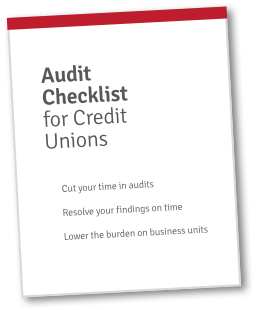Credit union internal audit programs accomplish a lot with relatively few resources. At Redboard, we want to ensure your audit team has a clear path to success.
Unfortunately, there are few resources available to credit union auditors. Even fewer of them are free.
So, we’ve compiled six free resources for credit union internal auditors. These include worksheets, checklists, frameworks, and more.
1. The Unresolved Findings Eliminator
Our free Unresolved Findings Eliminator worksheet helps your internal audit program prevent overdue and unresolved findings through the following:
-
- Build an optimized audit findings structure;
- Empower business units to resolve findings on time; and
- Execute a reminder system.
This findings management toolkit has helped credit unions of all sizes reduce their audit administration time considerably. Access it here.
2. The Credit Union Audit Checklist
We first created our audit checklist years ago. Since then, it has been downloaded countless times completely free.
It helps auditors outline key roles, expected due dates, and focus areas. It also helps them uncover historical results and data so that your team can leverage the past.
This checklist is a simple but effective tool for preparing previous data, making plans, and provides a few suggested procedures.
We strongly recommend familiarizing yourself with the NCUA examiner’s guide. There are few other documents out there that will better prepare you for understanding the NCUA’s regulatory methods and priorities.
In particular, they outline several strategies and priorities to address your organization’s improvement in the following areas:
- Effectiveness and efficiency of operations.
- Reliability of financial reporting.
- Compliance with applicable laws and regulations.
So, from risk management, to control systems, to governance processes, they’ll provide necessary insight.
5. Review the Three Lines of Defense
The three lines of defense is a common way of looking at risk management. The Institute of Internal Auditors (IIA) developed a complex structure to describe their new “three lines of defense” model. However, the original, simplified version is just as valid today—especially for credit union internal audit programs.
The three lines are, roughly:
-
- Risk owners and managers
- Risk control and compliance
- Risk assurance
We recommend reading more about how these lines of defense pertain to credit union auditors here and here.
6. Audit and Compliance Blogs
There’s always something new in credit union compliance. As new technologies, systems, and strategies emerge, so do new risks.
We like to keep up on the latest by reading the best credit union audit and compliance blogs.
Thanks for reading, and happy auditing!



 Get FREE Access to the Audit Checklist for Credit Unions!
Get FREE Access to the Audit Checklist for Credit Unions!


